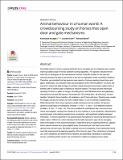Files in this item
Animal behaviour in a human world : a crowdsourcing study on horses that open door and gate mechanisms
Item metadata
| dc.contributor.author | Krueger, Konstanze | |
| dc.contributor.author | Esch, Laureen | |
| dc.contributor.author | Byrne, Richard | |
| dc.date.accessioned | 2019-06-28T16:30:01Z | |
| dc.date.available | 2019-06-28T16:30:01Z | |
| dc.date.issued | 2019-06-26 | |
| dc.identifier | 259401595 | |
| dc.identifier | ec9f747f-031b-4115-895b-1addba5c80ce | |
| dc.identifier | 85068901065 | |
| dc.identifier | 000482883600071 | |
| dc.identifier.citation | Krueger , K , Esch , L & Byrne , R 2019 , ' Animal behaviour in a human world : a crowdsourcing study on horses that open door and gate mechanisms ' , PLoS ONE , vol. 14 , no. 6 , e0218954 . https://doi.org/10.1371/journal.pone.0218954 | en |
| dc.identifier.issn | 1932-6203 | |
| dc.identifier.other | RIS: urn:3E4000C9FA92C543075511FCD9A59839 | |
| dc.identifier.other | ORCID: /0000-0001-9862-9373/work/60630535 | |
| dc.identifier.uri | https://hdl.handle.net/10023/18001 | |
| dc.description | This research received funding from the Ministry of Science, Research and Art (MWK), Baden-Württemberg, Germany. | en |
| dc.description.abstract | Anecdotal reports of horses opening fastened doors and gates are an intriguing way of exploring the possible scope of horses’ problem-solving capacities. The species’ natural environment has no analogues of the mechanisms involved. Scientific studies on the topic are missing, because the rate of occurrence is too low for exploration under controlled conditions. Therefore, we compiled from lay persons case reports of horses opening closed doors and gates. Additionally, we collected video documentations at the internet platform YouTube, taking care to select raw data footage of unedited, clearly described and clearly visible cases of animals with no distinct signs of training or reduced welfare. The data included individuals opening 513 doors or gates on hinges, 49 sliding doors, and 33 barred doors and gateways; mechanisms included 260 cases of horizontal and 155 vertical bars, 43 twist locks, 42 door handles, 34 electric fence handles, 40 carabiners, and 2 locks with keys. Opening was usually for escape, but also for access to food or stable-mates, or out of curiosity or playfulness. While 56 percent of the horses opened a single mechanism at one location, 44 percent opened several types of mechanism (median = 2, min. = 1, max. = 5) at different locations (median = 2, min. = 1, max. = 4). The more complex the mechanism was, the more movements were applied, varying from median 2 for door handles to 10 for carabiners. Mechanisms requiring head- or lip-twisting needed more movements, with significant variation between individuals. 74 horses reported in the questionnaire had options for observing the behaviour in stable mates, 183 did not, which indicates that the latter learned to open doors and gates either individually or from observing humans. Experience favours opening efficiency; subjects which opened several door types applied fewer movements per lock than horses which opened only one door type. We failed to identify a level of complexity of door-fastening mechanism that was beyond the learning capacity of the horse to open. Thus, all devices in frequent use, even carabiners and electric fence handles, are potentially vulnerable to opening by horses, something which needs to be considered in relation to keeping horses safely. | |
| dc.format.extent | 20 | |
| dc.format.extent | 2497416 | |
| dc.language.iso | eng | |
| dc.relation.ispartof | PLoS ONE | en |
| dc.subject | BF Psychology | en |
| dc.subject | QH301 Biology | en |
| dc.subject | NDAS | en |
| dc.subject.lcc | BF | en |
| dc.subject.lcc | QH301 | en |
| dc.title | Animal behaviour in a human world : a crowdsourcing study on horses that open door and gate mechanisms | en |
| dc.type | Journal article | en |
| dc.contributor.institution | University of St Andrews. School of Psychology and Neuroscience | en |
| dc.identifier.doi | https://doi.org/10.1371/journal.pone.0218954 | |
| dc.description.status | Peer reviewed | en |
This item appears in the following Collection(s)
Items in the St Andrews Research Repository are protected by copyright, with all rights reserved, unless otherwise indicated.

